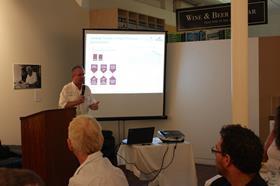
With renowned Mildura chefs on hand to create tasty melon recipes, Australian melon growers were treated to an insight into new melon varieties in trial and offered advice on how to grow the market both domestically and overseas.
The Seminis Melon Insights Breakfast took place at Stefano’s Cafe ahead of the Bayer Australian Melon Association conference on 16 March, which brought the industry together to discuss disease, quality and the next step forward.
On the menu were some of Seminis' newer melons, including Piel de Sapo, which is already on Australian retail shelves, and Seminis’ Sweet Peak Fuji and Banzai melons.
Speaking at the event, Bruno Libbrecht, global product manager cucurbits Monsanto US, offered advice on the trends in fresh produce industry that are driving consumers trends.
From healthy eating and the rise in organics to food safety, Libbrecht said that all of these factors were something that the melon industry could be a part of.
“Millennials have been very influential on the fruit industry today and while every generation would like be healthier, millennials are the only generation willing to pay for health,” Libbrecht said, adding that sales of organic fruit have continued to grow.
On top of that, the prevalence of branding among millennials has flowed down into the produce sector, where branding still remains minimal.
To take advantage of these trends, Australian growers should focus on specialisation, Libbrecht said, partnering with a breeder to produce the best quality product for the local market and building up a brand, and then, possibly moving on to exploring exports, Libbrecht advised,
Towards branding and diversifying use
Rachel Palumbo, Monsanto ANZ vegetable commercial lead, told Produce Plus that tomatoes are an example of where branding and expanding SKUs has worked.
“Melons have probably lost some elegance among consumers and we do see opportunities for new varieties,” Palumbo said. “Just as we’ve seen the growth in snacking tomatoes, there’s opportunities to push melons for difference uses.
“A few years ago, there were a few tomato SKUs in a supermarket. Now, there’s a sea of red, with around 18 SKUs in stores. That’s a huge diversification, with a range of uses, brands, new products – all delivered through consistent quality and branding,” Palumbo said.
Using the example of the stripy skinned ‘Piel de Sapo’ melon, Palumbo said the amount of retail shelf space given to this new variety is proof that the door is open to diversification within the melon market.
“The Australian melon industry has been losing shelf space to berries. So what can the melon industry do to differentiate? It’s about a different eating experience,” Palumbo said.
Monsanto’s vegetable seed business Seminis has been working on improving flavour in its melons, from taste, texture and aroma to juiciness and colour, as well as working on improving shelf life in order to boost export opportunities.
In the next few years, Seminis is hoping to develop more disease resistant varieties, as well as its sweeter melons that have proved popular in the US, such as the Sweet Trick, which works well as a fresh cut product, and the Summer Slice seedless watermelon.
Quality, quality, quality
In terms of where the opportunities lie for the Australian melon industry, Libbrecht said it was all about “quality, quality, quality”.
Using examples from across the globe, from the expensive, high-quality melons sold in Japan, where consumers showed a willingness to pay for quality, to Mexico, where NIR technology is used to set a minimum brix, making them one of the few countries exporting melons to Japan.
In Italy and France, similar technology is being used to measure each melon, guaranteeing minimum brix and sorting melons into lines of premium, classic and organic.
Libbrecht said NIR technology could mean that one day retailers themselves would have the machines to measure brix, meaning growers would need to produce consistent, quality melons.



